The Reserve Bank has cut the Official Cash Rate (OCR) by another 50 basis points to 4.75%, but CoreLogic NZ Chief Property Economist, Kelvin Davidson, says August’s OCR cut has yet to boost house prices and difficult decisions are still ahead for borrowers

CoreLogic’s hedonic Home Value Index (HVI) showed another subdued month for the property market in September, with values down by a further 0.5%. That was the seventh monthly fall in a row.
Since February, the declines have now reached a total of 4.7% at the national level, reducing values by $39,399, from $844,825 to $805,426.
Values are still around 16% higher than the March 2020 pre-COVID level, but remain almost 18% below the peak at the height of the post-COVID boom.
The main centres showed a mixed bag of results in September, with Hamilton down 1.2%, Auckland falling a further 0.7% (pushing the recent falls to a total of more than 7%), and Wellington by 0.5%. Yet Tauranga saw a more modest drop of 0.3%, Christchurch was flat, and Dunedin edged up by 0.1%.
The latest home value data remains patchy and generally sluggish across the country.
There are signs that lower mortgage rates have started to boost sentiment in the housing market, but this is yet to meaningfully flow through to hard pricing indicators.
To be fair, the trough for this latest episode of falling property values may not be far away. But I’d be cautious of assuming that the end of a downturn suddenly means the start of the next upturn. Reasons for caution include still-stretched housing affordability in most parts of the country, an elevated stock of listings on the market, and the weaker employment figures that are now showing through.
Difficult mortgage decisions for borrowers likely to continue
The near-term path for mortgage rates remains downwards and this should continue into 2025, but lower rates will also bring forward the timing for when the new debt to income restrictions start to bind.
DTI rules went live on July 1st, but will become more relevant as borrowing capacity expands alongside lower interest rates, suggesting that any house price upturn next year could be more muted than in the past.
The ‘perfect’ strategy for fixing mortgage rates through time is only ever known in hindsight, however new data points to a strong preference for short-term loans.
At a macro level this means any reduction in rates will flow through to balance sheets quickly, but with the labour market weakening there are clear ‘tail risks’ to watch for in terms of rising loan repayment problems.
As it’s become clear in recent months that the medium-term outlook is for fairly steady declines in the official cash rate and mortgage interest rates, there’s been a strong preference for borrowers to take out short-term fixed loans. In December last year, for example, 36% of new loans (by value) were taken out for a fixed term of up to 12 months. But that had spiked to 56% by February and reached a new record high of 68% in August – driven by an especially large surge in six-month activity, off the back of that first OCR cut.
Our analysis suggests that existing borrowers who are rolling over their loans onto a new fixed rate will have been behaving in a very similar way to new borrowers, and indeed the Reserve Bank’s figures show that the share of existing loans that are currently fixed but due to change mortgage rates (‘reprice’) within the next 12 months has now risen back to around 66% – matching a peak previously seen in the first half of 2021. Some of that stock growth will have also come from all of those recent new borrowers who have been fixing short too.
In hindsight, it might not have been the best decision for borrowers – in aggregate – to fix for such short periods back in mid-2021 (unless they wanted loan flexibility for lump sum repayments, as an example). Indeed, anybody who bucked the trend and took out a five-year rate of around 3% at that time will still have about 18 months to run at those ultra-low rates. On the other hand, one can understand why borrowers are now choosing to take shorter fixed periods in the hope they will benefit from a series of loan renewals in the coming year or two at ever-lower rates.
On that note, the one-year change in the average ‘special’ (high equity) one-year fixed mortgage rate, for example, has recently turned negative for the first time since mid-2021; i.e. people currently rolling off a one-year rate from October 2023 will be seeing their costs fall. Some of the currently available market interest rates have recently dropped below the average rate prevailing across the stock of existing fixed loans for the first time in about three years too.
Of course, much like it wasn’t necessarily an easy decision to decide on the ‘best’ fixed rate back in mid-2021 (although it’s clearer in hindsight what should have happened), it’s not necessarily straight-forward now either. After all, the very short-term rates (e.g. six months fixed at 6.7%) remain quite a bit higher than the slightly longer terms (e.g. 12 months fixed at 6.2%) – so for the strategy of taking two consecutive six-month fixes to pay off (i.e. to get the lowest average rate over the relevant term), that rate basically needs to drop to 5.7% or less by April next year.
Could that happen? Nothing’s out of the question, especially given the continued weakness of the economy and an emerging risk that inflation falls much more sharply than has been anticipated; which would likely see the OCR also fall more rapidly, alongside extra downward pressure on mortgage rates. But at the same time, there could also be a sense at the moment that some of the potential future falls in the OCR have already been captured (‘priced in’) by current mortgage rates, meaning that the scope for more declines from here, regardless of the fixed term, could be a bit slower/smaller than what we’ve seen to date. Either way, the delicate decisions currently faced by mortgage borrowers may continue for a while yet.
In addition, even though interest rates are now falling, it doesn’t necessarily mean we’ve passed the worst for financial stress amongst mortgage borrowers. Indeed, the non-performing loans ratio (loans that are at least 90 days in arrears or regarded as impaired) on banks’ books has recently edged up to around 0.6% of existing mortgages, the highest figure in more than a decade. It was close to double that figure in 2009-10, however, these numbers are surely still a concern – and could continue to rise, given the job losses that we’re now seeing.
Based on RBNZ figures, the trading banks themselves recently seem to have been raising provisions for possible future ‘bad’ housing loans, to the point where these allowances are now about 40% above even the largest COVID-era figure. Mortgage stress will remain a factor to watch for some time to come yet and is another reason to be cautious about the size and strength of any upturn in house sales and prices as we head into 2025.
National and Main Centres
Auckland
Apart from stability in Franklin, each of Auckland’s sub-markets registered a fall in property values in September, ranging from 0.4% in Papakura up to 0.9% in Auckland City. Over the past three months, the falls in Rodney and Auckland City have topped 4%, although Papakura has been the weakest since the most recent peak (-8.3%).
Putting aside these variations from area to area, the bigger picture for Auckland’s housing market is one of generally renewed weakness.
Each of Auckland’s sub-markets now has a property value that’s at least 1.8% below a year ago, and it’s also pretty striking to note that Auckland City has only seen a rise in values of 4.4% since March 2020. In other words, there’s not much left of the post-COVID boom in that market, perhaps reflecting affordability restraints in its more expensive suburbs, but potentially also patchy demand for apartments.
Wellington
The Wellington area saw some variability in September, with Porirua’s property values rising by 0.4%, and Upper Hutt ticking slightly higher too. On the other hand, Wellington City dropped by 0.5%, and Lower Hutt’s fall exceeded 1%. However, taking a three-month horizon, the trend remains pretty clear, with each sub-market down by at least 2% since June. Lower Hutt and Kapiti Coast are closer to 4%.
Some anecdotes suggest that buyers are starting to eye up the Wellington market again, given a sense that affordability is becoming a bit more normal again, and also that there could be some bargains on offer for investors. However, looser labour market conditions probably loom larger in peoples’ decisions in Wellington than other parts of the country, suggesting that property values aren’t set to surge higher in the near term.
Regional results
Unsurprisingly, there were some varied results across NZ’s provincial markets in September, with Gisborne, Napier, and Hastings all dropping by more than 1%, but Queenstown was flat, while Nelson and Invercargill inched higher.
While all areas across NZ face similar pressures from key drivers such as elevated listings and still relatively high (albeit falling) mortgage rates, local factors can still play a very important role.
Invercargill, for example, may not always be on everybody’s radar as a ‘fashionable’ property market, but values there have risen by 5.2% in the past 12 months, versus a national drop of 1.2%. The revitalisation of the CBD might have been part of that story, but affordability stands out too – a median value of around $460,000 is certainly helping first home buyers to access Invercargill’s property market.”
Property market outlook
The recent drop in values might find a floor over the coming months, but at the same time it’s difficult to see a sharp turnaround in the final few months of 2024 – although the usual seasonal rise in sales activity is likely to become evident through the final quarter of the year.
Lower mortgage rates seem to be boosting confidence levels to some degree, and this could be helping some vendors to get closer to their ideal sale price. But finance-approved buyers still have the upper hand when it comes to negotiations, simply because the available stock on the market remains so high – more than 30% above the five-year average for this time of year. A rise in sales volumes may start to slowly reduce listings counts, but buyer choice will probably remain elevated into 2025.












